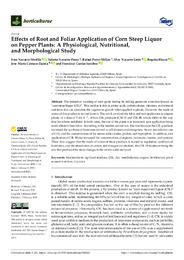Please use this identifier to cite or link to this item:
https://hdl.handle.net/11000/33467Full metadata record
| DC Field | Value | Language |
|---|---|---|
| dc.contributor.author | Navarro Morillo, Iván | - |
| dc.contributor.author | Navarro-Pérez, Valeria | - |
| dc.contributor.author | Perez-Millan, Rafael | - |
| dc.contributor.author | Navarro-León, Eloy | - |
| dc.contributor.author | Blasco León, Begoña | - |
| dc.contributor.author | Cámara-Zapata, José-María | - |
| dc.contributor.author | Garcia-Sanchez, Francisco | - |
| dc.contributor.other | Departamentos de la UMH::Física Aplicada | es_ES |
| dc.date.accessioned | 2024-10-11T11:07:03Z | - |
| dc.date.available | 2024-10-11T11:07:03Z | - |
| dc.date.created | 2023-02-07 | - |
| dc.identifier.citation | Horticulturae 2023, 9(2) | es_ES |
| dc.identifier.issn | 2311-7524 | - |
| dc.identifier.uri | https://hdl.handle.net/11000/33467 | - |
| dc.description.abstract | The industrial washing of corn grain during its milling generates a residue known as “corn steep liquor (CSL)”. This residue is rich in amino acids, carbohydrates, vitamins, and mineral nutrients that can stimulate the vegetative growth when applied to plants. However, the mode of action of this product is not yet known. This work involved the foliar and root application to pepper plants, at a dose of 5 mL L−1, of two CSL products (CSL-H and CSL-B), which differ in the way they have been stabilized. In both cases, the size of the plants was increased, root application being more efficient than foliar. According to the studies carried out, this was because the CSL products increased the synthesis of hormones related to cell division and elongation, the net assimilation rate of CO2, and the concentrations of the amino acids alanine, proline, and tryptophan. In addition, root application of CSL-H also increased the concentrations of arginine, isoleucine, leucine, and cysteine. These data suggest that the mode of action of these products is related to regulation, synthesis of hormones, and the stimulation of carbon and nitrogen metabolism, the CSL-H treatment being the one that produced the most changes in the amino acids analyzed | es_ES |
| dc.format | application/pdf | es_ES |
| dc.format.extent | 16 | es_ES |
| dc.language.iso | eng | es_ES |
| dc.publisher | MDPI | es_ES |
| dc.rights | info:eu-repo/semantics/openAccess | es_ES |
| dc.rights | Attribution-NonCommercial-NoDerivatives 4.0 Internacional | * |
| dc.rights.uri | http://creativecommons.org/licenses/by-nc-nd/4.0/ | * |
| dc.subject | Biostimulants | es_ES |
| dc.subject | Agrifood residues | es_ES |
| dc.subject | CSL | es_ES |
| dc.subject | Zea | es_ES |
| dc.subject | Metabolomics | es_ES |
| dc.subject | Organic fertilization | es_ES |
| dc.subject | Plant mineral nutrition | es_ES |
| dc.subject | Capsicum | es_ES |
| dc.title | Effects of Root and Foliar Application of Corn Steep Liquor on Pepper Plants: A Physiological, Nutritional, and Morphological Study | es_ES |
| dc.type | info:eu-repo/semantics/article | es_ES |
| dc.relation.publisherversion | https://doi.org/10.3390/horticulturae9020221 | es_ES |

View/Open:
Effects of root and foliar application of corn steep liquor on pepper plants.pdf
676,29 kB
Adobe PDF
Share:
.png)
